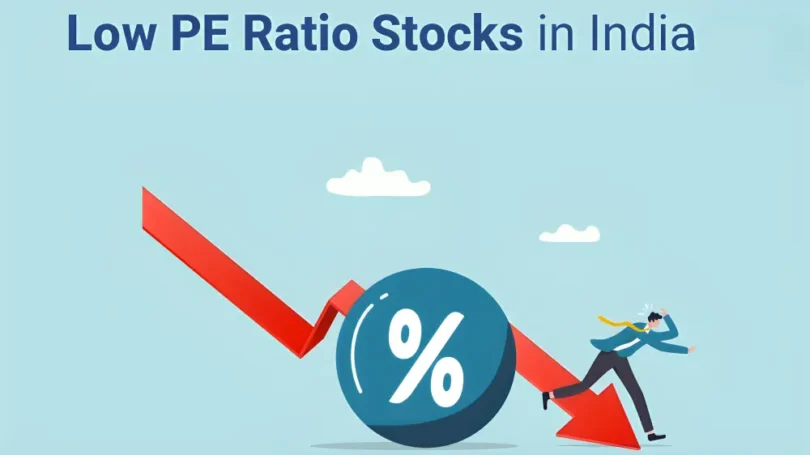When investing in a firm, investors take several fundamental factors into account. The following are some of the often-used indicators: price-to-earnings ratio (PE), debt-to-equity ratio (D/E), ROCE (return on capital employed), ROE (return on equity), and EPS (earnings per share). Among them, the price-to-earnings ratio (PE ratio) is used to determine a stock’s genuine market worth and is a cornerstone of financial research. Are you trying to find an inventory of companies with Low PE Ratio Stocks in India? Let’s look at what PE is, why investors care, and how it’s calculated. Find out which Low PE Ratio Stocks in India are on this list and what to consider before investing in them in 2024.
What is the PE ratio?
The P/E ratio, also known as the price-to-earnings ratio, evaluates a company’s earnings about its stock price. Investors can quickly determine whether a company is valued high or low with its earnings by employing this technique. Generally speaking, a high P/E ratio indicates that a stock is expensive relative to its earnings, whereas a low P/E ratio indicates that a stock is inexpensive. With the help of this crucial instrument, one can use the company’s current financial performance to influence judgments about purchasing or selling stocks.
How to Calculate PE Ratio?
Utilize the following formula to determine the Price-to-Earnings (P/E) ratio:
For example, if a stock’s EPS was ₹14 and its current market price was ₹126.42, the P/E ratio would be 9.03. This implies that investors are willing to pay ₹9.03 for every rupee of earnings, or that the market values the company at about ₹126.42 for every ₹14 in earnings.
Please Note: Comparing the P/E ratio to the industry average yields a more accurate assessment of the company’s market position.
Fundamentals of Companies with Low PE Ratio Stocks in India
Large-Cap Stocks With Low PE Ratio
| Company name | P/E | Market Cap (Crore) |
| State Bank of India (SBI) | 7.38 | Rs. 5.07L |
| Oil and Natural Gas Corporation (ONGC) | 5.14 | Rs. 2.41L |
| Coal India | 7.56 | Rs. 2.11L |
| Adani Power | 8.43 | Rs. 1.71L |
| Indian Oil Corporation Ltd (IOCL) | 3.96 | Rs. 1.52L |
State Bank of India (SBI)
SBI is the largest international banking and financial services company in India, with its main office in Mumbai. In India, it operates 22,219 branches and 62,617 ATMs. The bank’s market shares in terms of advances and deposits are 19.69% and 22.84%, respectively. SBI ranked 235th out of the Fortune Global 500. Nearly 45 crore Indians rely on SBI for loans, wealth management, personal and business banking, and other services. Over the past five years, SBI’s profit growth has been a steady 76%.
Oil and Natural Gas Corporation (ONGC)
The largest exploration and production company for natural gas and crude oil in India, ONGC is based in New Delhi. It contributes 71% of India’s domestic output and is located in 8 of the country’s 9 producing basins (in Gujarat, Assam, Rajasthan, Mumbai, Krishna Godavari, Cauvery, Bengal, and Vindhyan). ONGC’s reserves create petroleum products such as LPG cooking gas, fuel, kerosene, and gasoline.
Coal India
The largest coal mining and refining firm in the world, Coal India Limited is run by the Indian government’s Ministry of Coal and has its headquarters in Kolkata. Nearly 82% of India’s total coal production comes from CIL. As of April 1, 2020, Coal India operated 352 mines across eight distinct Indian states. As of October 30, 2023, CIL employed around 239,000 individuals, making it one of the largest corporate employers.
Adani Power
Adani Power, the biggest producer of private thermal electricity in India, is situated in Ahmedabad. The company has 13,650 MW of installed capacity and operates thermal power plants in six Indian states: Gujarat, Maharashtra, Karnataka, Rajasthan, Madhya Pradesh, and Chhattisgarh.
Indian Oil Corporation Limited (IOCL)
Indian Oil Corporation is the biggest commercial oil corporation owned by the Indian government. Eleven of India’s twenty-three refineries are operated by this Maharatna company, which has its headquarters in New Delhi. With a network of more than 56,000 customer touchpoints, a 33% market share in petroleum products, and a 71% share in the downstream industry, IOCL is a major participant in India’s energy scene.
Mid-Cap Stocks with Low PE Ratio
| Company name | P/E | Market Cap (Crore) |
| Housing and Urban Development Corporation (HUDCO) | 9.13 | Rs. 16.33K |
| Manappuram Finance | 7.29 | Rs. 13.54K |
| Calcutta Electric Supply Corporation (CESC) | 9.14 | Rs. 13.22K |
| Karur Vysya Bank | 9 | Rs. 12.27K |
| Authum Investment and Infrastructure | 5.82 | Rs. 11.97K |
Small-Cap Stocks With Low PE Ratio
| Company name | P/E | Market cap (crores) |
| PTC India | 8.92 | Rs. 4.65K |
| West Coast Paper | 4.37 | Rs. 4.33K |
| DCB Bank | 6.88 | Rs. 3.51K |
| Brightcom Group | 2.32 | Rs. 3.27K |
| Prakash Industries | 9.84 | Rs. 2.78K |
Conclusion
Investing in Low PE Ratio Stocks in India might provide good returns because they are inexpensive. Nevertheless, you shouldn’t base all of your investment decisions just on the P/E ratio. Examine the company’s financials, the sector PE ratio, and other important metrics. In addition, remember to take your timeframe, risk tolerance, and investment aim into account. Before investing, thoroughly review all relevant documentation as there are market risks related to investing in the securities market.
When selecting an investment fund or constructing a portfolio that meets your needs, please take into account your unique investing criteria, risk tolerance, goal, time horizon, risk and reward balance, and the cost of the investment. Any investment portfolio’s performance and returns are neither assured nor predictable.








Leave a Comment